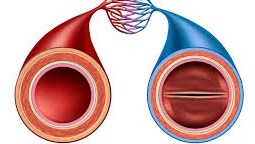Artery vs. Vein: What's the Difference?
By Kara Heer - February 4, 2022
Artery .vs Vein - What's The Difference?
The blood vessels in our bodies that make up the cardiovascular system are veins, arteries and arterioles. Arteries are blood vessels that carry oxygen in the blood away from the heart to other parts of the body such as the brain, organs, arms and legs. The purpose of your cardiovascular system is to transport nutrients and oxygen to every part of your body. Arteries and veins work together through an intricate system to keep blood flowing properly throughout your body.
What are Arteries?
There are three types of arteries, each with layers known as inner, middle and outer walls.
Elastic arteries: Also referred to as conducting arteries, these have a thick middle coat that allows them to stretch every time one's heart beats. The aorta is the largest artery in the body; it carries freshly oxygenated blood from the heart out to all the other major arteries, which continue to branch off into smaller and smaller arteries bringing blood all the way down to our fingers and toes. The aorta starts at the heart, goes up to the brain via the carotid arteries, then down the length of the torso, where it splits at each leg, becoming femoral arteries which in turn deliver blood to our legs.-
Muscular arteries: These medium-sized arteries bring blood back from the elastic arteries and go off into resistance vessels, including small arteries and arterioles. These are the muscles in our abdomen, back and legs.
-
Arterioles: These are the smallest arteries that are responsible for pushing blood into the capillary networks. Capillary networks are the smallest of vessels where arteries become veins and begin the journey back to the lungs and heart where the process begins again.
What Are Veins?
Veins are blood vessels that carry blood that is now low in oxygen back to the lungs where it will become oxygenated, and on to the heart where it gets pumped out to the body again. The superior and inferior vena cava are the largest of your bodies veins. Similar to the aorta, the vena cava runs the length of the torso, but with the blood flowing the opposite direction. Similar to arteries, they also branch into smaller veins whose goal it is to return all the blood to the lungs and heart.
What makes veins special is they have one-way valves in the innermost layer that open and close with each heartbeat to prevent blood from flowing backwards. The valves in the legs are very strong and keep the blood moving up towards the vena cava. The major veins in the legs are the saphenous veins. Muscles surrounding your veins also help push blood back to your heart, contracting when you walk or run.
There are four types of veins:
- Deep veins: These are located near an artery and can be located inside your muscle tissue.
- Superficial veins: These aren't located near an artery and can be located near the surface of your skin.
- Pulmonary veins: These bring oxygen-rich blood from the lungs to the heart.
- Systemic veins: These bring deoxygenated blood from all areas of the body back to your heart.
Common Illnesses in Arteries & Veins
When your arteries and veins aren't healthy, your overall health suffers. Some of the most common cardiovascular problems include:
- Artery plaque: Also known as atherosclerosis, this illness occurs when plaque builds up inside one's arteries from cholesterol (fatty diet), smoking and lack of physical movement. When plaque builds up too thick for blood to pass, it can cause damage to the brain (stroke), heart and cause blockages to the legs and feet.
-
Varicose veins: These occur when your leg veins have trouble returning blood back to your heart. They can become unsightly, bulging, and uncomfortable. In some cases, some blood may regurgitate back downwards. This can cause swelling and discomfort in the legs and feet.
Vascular Health
Healthy arteries and veins play a critical role in maintaining good overall health. Fortunately, caring for your cardiovascular system is easier than you may think. By eating a low-fat diet, exercising regularly, and managing your stress, you'll be well on your way to having strong arteries and veins. For more tips on how to keep your cardiovascular system in tip-top shape, the trusted team at the Vascular Institute of the Rockies is here to help. Contact us today!
